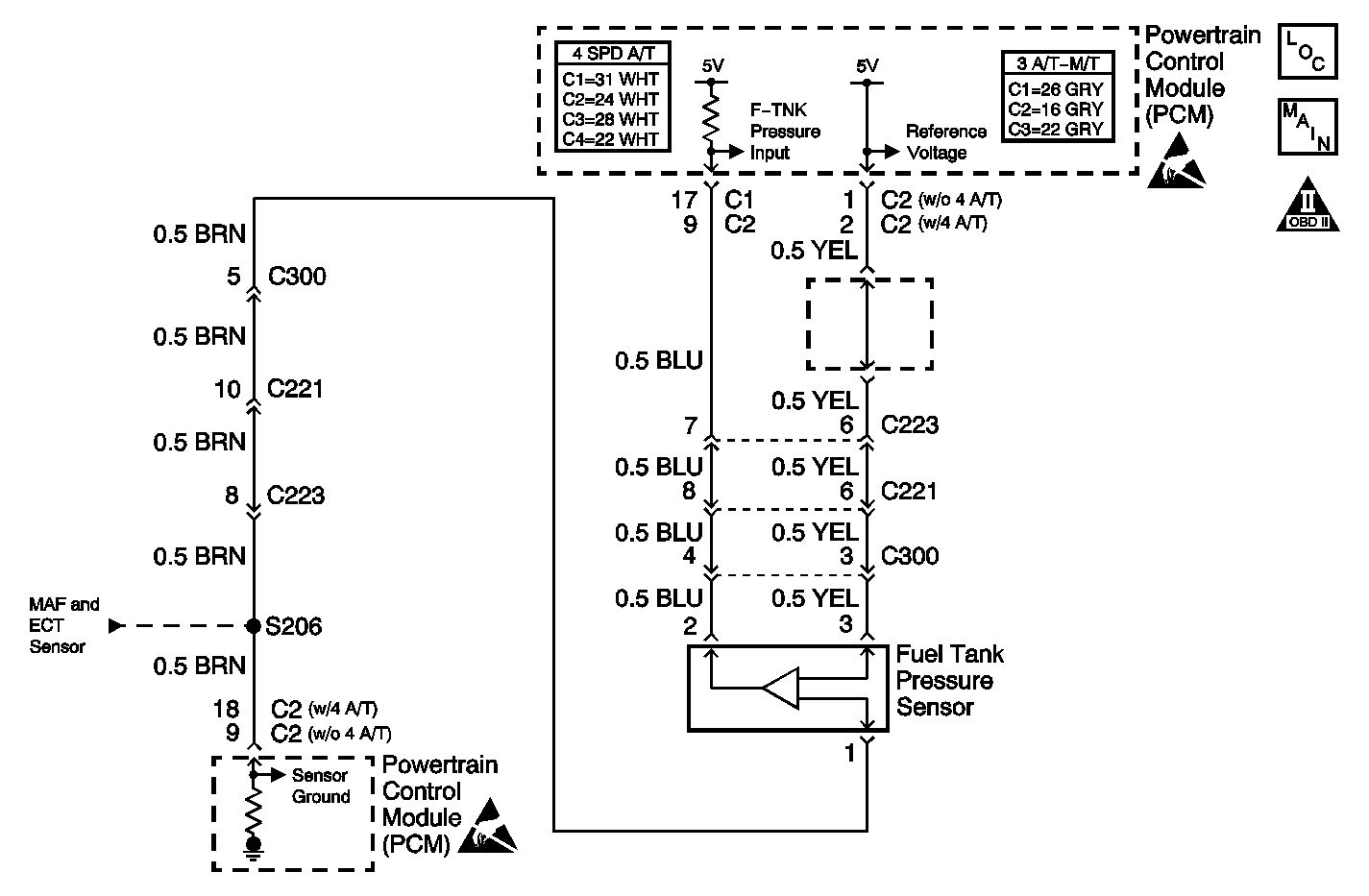
Circuit Description
The evaporative emission (EVAP) control system prevents the emission of the fuel vapors. The fuel vapor generated in the fuel tank while driving or idling enters the EVAP canister where a charcoal element absorbs and stores the fuel vapor. When certain engine operating conditions are met the powertrain control module (PCM) purges the EVAP canister of stored vapors by turning ON the EVAP canister purge valve.
Emissions laws require that the PCM detect any leakage within the EVAP system. The PCM monitors the fuel tank pressure (FTP) sensor in order to detect any abnormalities within the EVAP system.
The PCM supplies a 5 volt reference voltage, a sensor ground, and an input signal circuit to the FTP sensor.
Conditions for Running the DTC
The engine has been running less than 10 seconds.
Conditions for Setting the DTC
The FTP sensor signal indicates less than -30.48 mm Hg (16.3 in H2O) for 7 seconds.
OR:
The FTP sensor signal indicates more than 15.24 mm Hg (8.16 in H2O) for 7 seconds.
Action Taken When the DTC Sets
| • | The PCM illuminates the malfunction indicator lamp (MIL) after 2 consecutive ignition cycles in which the diagnostic runs with the fault active. |
| • | The PCM records the operating conditions at the time the diagnostic fails. This information is stored in the Freeze Frame buffer. |
Conditions for Clearing the MIL/DTC
| • | The MIL turns OFF after 3 consecutively passing trips without a fault present. |
| • | A History DTC clears after 40 consecutive warm-up cycles without a fault. |
| • | Use the scan tool Clear DTC Information function. |
Diagnostic Aids
If DTCs P0100, P0110, P0115, and P0120 are also set, the malfunction may be in the sensor ground circuit.
If a DTC P0120 are also set, the malfunction may be in the reference voltage circuit.
If a DTC P0450 is intermittent, road test the vehicle while observing the fuel tank pressure sensor with a scan tool. A momentary reading of -30.0 mm Hg (-16 in H2O) or less may indicate an intermittent short to ground in the sensor input circuit. A momentary reading of 15.0 mm Hg (8 in H2O) or more may indicate an open in the sensor input or ground circuit.
To perform a functional check of the FTP sensor, refer to Evaporative Emission Control System Diagnosis .
An intermittent malfunction may be caused by a fault in the sensor electrical circuit. Inspect the wiring harness and the components for an intermittent condition. Refer to Intermittent Conditions .
Repair any electrical circuit faults that were found. Refer to Wiring Repairs in Wiring Systems.
The information included in the Freeze Frame data can be useful in determining the vehicle operating conditions when the DTC first set.
Test Description
The numbers below refer to the step numbers in the diagnostic table.
-
The OBD System Check prompts the technician to complete some basic checks and store the Freeze Frame data on the scan tool if applicable. This creates an electronic copy of the data taken when the fault occurred. The information is then stored in the scan tool for later reference.
-
This step determines if a fuel tank pressure sensor malfunction is present. The input signal of the fuel tank pressure sensor should indicate atmospheric pressure with the fuel tank filler cap removed. The fuel tank pressure sensor will vary with atmospheric pressure. A typical pressure at sea level is between 0.0-0.99 mm Hg (0.0-0.5 in H2O).
-
This step determines if DTC P0450 is the result of a hard failure or an intermittent condition. Operating the vehicle in the Check mode enhances the diagnostic capabilities of the PCM. For additional information on the Check mode operation refer to Powertrain Control Module Diagnosis.
-
This step checks whether there is trapped negative or positive pressure at the FTP sensor.
-
Checks for an open or a short in the FTP sensor 5 volt reference.
-
Checks for an open or short in the FTP sensor input circuit.
-
Checks for an open in the FTP sensor ground circuit.
Step | Action | Values | Yes | No | ||||
|---|---|---|---|---|---|---|---|---|
Did you perform the Powertrain On-Board Diagnostic (OBD) System Check? | -- | |||||||
Is the fuel tank pressure sensor within the specified range? | 0.0-0.99 mm Hg (0.0-0.5 in H2O) | |||||||
Does DTC P0450 set? | -- | Go to Diagnostic Aids | ||||||
Is the fuel tank pressure sensor within the specified range? | 0.0-0.99 mm Hg (0.0-0.5 in H2O) | |||||||
5 |
Is the action complete? | -- | -- | |||||
Does the voltage equal the specified value? | 5.0 V | |||||||
Measure the voltage from the FTP sensor connector cavity 2 on the harness side using a DMM. Is the voltage near the specified value? | 4.9 V | |||||||
8 | Repair the open in the reference voltage circuit of the fuel tank pressure sensor between the sensor and SP259. Refer to Wiring Repairs in Wiring Systems. Is the action complete? | -- | -- | |||||
9 |
Was a repair necessary? | -- | ||||||
Probe the FTP sensor connector cavity 1 on the harness side with a test lamp connected to battery voltage. Does the test lamp illuminate? | -- | |||||||
11 | Repair the open in the ground circuit of the fuel tank pressure sensor between the sensor and S206. Refer to Wiring Repairs in Wiring Systems. Is the action complete? | -- | -- | |||||
12 | Replace the FTP sensor. Refer to Fuel Tank Pressure Sensor Replacement . Is the action complete? | -- | -- | |||||
13 | Replace the PCM. Refer to Powertrain Control Module Replacement . Is the action complete? | -- | -- | |||||
14 |
Are any DTCs displayed on the scan tool? | -- | System OK |
